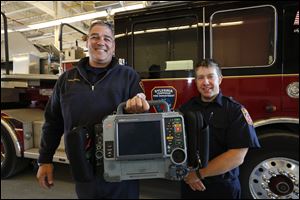
Tackling heart attacks in Sylvania Twp.
Firefighters, ProMedica work together for speedier response
8/18/2014
Sylvania Township firefighter/paramedics Greg Wilcox, left, and David Shutters display a LifePak 15 monitor/defibrillator at Fire Station No. 4 in Sylvania Township.
Sylvania Township Fire Department paramedics and ProMedica Toledo Hospital are working together to improve intervention times when a patient is experiencing a cardiac emergency.
For the past year the two organizations, along with other Toledo-area fire departments, have implemented a protocol in which a patient experiencing a heart attack bypasses the emergency room and is sent directly to the catheterization lab, where the awaiting doctor is already prepared to provide care.
“We had been talking about it for a while and there are institutions around [ProMedica] that can do it. Bottom line, it is better for the patients to lower time and reduce the risk of heart damage,” said Julia Harsh, Toledo Hospital’s chest pain coordinator.
The streamlined program for dealing with patients with ST-segment elevation myocardial infarction, a type of serious heart attack, began as a pilot program at the hospital in January. Because of its success the hospital made it a permanent program in July.
The American Heart Association defines a STEMI as the most severe type of heart attack caused by a complete blockage of blood flow to the heart. It says that to “prevent death, it’s critical to restore blood flow as quickly as possible by surgically opening the blocked vessel or administering intravenous clot-busting medication.”
Other hospitals in Toledo also can treat STEMIs, including ProMedica St. Luke’s and Mercy St. Vincent Medical Center. For Sylvania and Sylvania Township residents, ProMedica Toledo Hospital is the closest and its protocol has reduced overall treatment time from 60 minutes to an average of 34 minutes, Mrs. Harsh said. That time takes into account the patient’s initial contact with the Township firefighters and the care received at the hospital.
Brent Parquette, training and quality assurance specialist for Lucas County EMS, has been training paramedics for the past 16 years to read electrocardiograms, or ECG tests, which measures a heart’s electrical activity.
Today there are about 400 paramedics in the system who can discern when a patient is having a heart attack and if it is a STEMI. Of these, 55 are Sylvania Township firefighters who double as paramedics.
The township receives about 40 to 50 calls annually related to STEMIs
Each Township fire engine is outfitted with an ECG diagnostic system, which costs about $28,000.
“The paramedic’s role is very crucial. They are the first one on the scene diagnosing the STEMI, starting the initial care with an IV or aspirin,” Mrs. Harsh said.
Mrs. Harsh said paramedics or firemen have assisted doctors inside the cath lab, administering CPR and medicine if a patient goes into cardiac arrest.
“Anything they are licensed to do in the field they are allowed to do here,” she said.
Contact Natalie Trusso Cafarello at: 419-206-0356, or ntrusso@theblade.com, or on Twitter @natalietrusso.